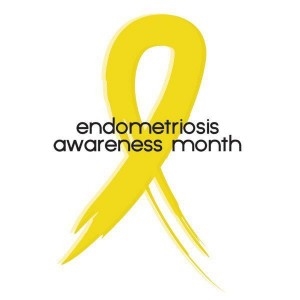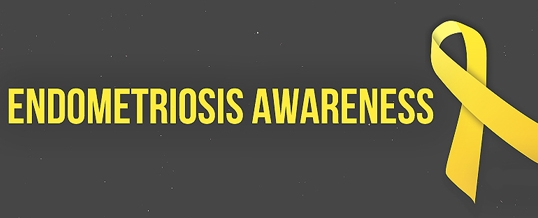Endometriosis Month on March, 2025: endometriosis?
March, 2025 is Endometriosis Month 2025. Endometriosis Pain Study If You Have Endometriosis Learn About A Research Study
As an Amazon Associate I earn from qualifying purchases.

From the Endo Research Center, a free foundation for Endo, available online at www.endocenter.org:
"Endometriosis, a leading cause of pelvic pain, hysterectomy and female infertility, is a reproductive and immunological disease affecting nearly 89 million women and teens worldwide. The average delay in diagnosis is a staggering 9 years, and the disease can only be definitively diagnosed through gynecologic surgery.
With Endometriosis, tissue like the endometrium is found outside the uterus, in other areas of the body. These growths, called "implants" or "lesions," still respond to hormonal commands each month, breaking down and bleeding. However, unlike the endometrium, the tissue has no way of leaving the body. The result is internal bleeding, degeneration of blood and tissue shed from the growths, inflammation of the surrounding areas and formation of scar tissue. Depending on the location of the growths, interference with the bowel, bladder, intestines and other areas of the abdominal cavity can occur. Endometriosis has even been found lodged in the skin, the lungs and even the brain.
There is currently no definitive cure for Endometriosis, but there are several effective methods of disease management. Many women can and do live well in spite of their Endometriosis.
Endometriosis staging has been defined by the American Society for Reproductive Medicine, with criteria based on the location, amount, depth and size of disease implants. These factors are graded on a point system based on biopsy samples obtained during surgery. The first classification scheme was developed in 1973, but since then it has been revised and refined 3 times for a more precise method of documentation. As of 1985, the stages are classified as 1 though 4; minimal, mild, moderate, and severe. Stage is not indicative of pain levels, infertility or symptoms. A woman in Stage 4 can be asymptomatic while a Stage 1 patient might be in debilitating pain.
Malignant transformation of Endometriosis can and does occur. Some researchers even estimate that approximately 0.7-1.0% of patients with Endometriosis have lesions that will ultimately undergo malignant transformation, and urge consideration of performing bilateral oophorectomy at the time of abdominal surgery in patients with significant disease. We have also begun learning of the elevated risks women with the disease have for certain cancers, including non-Hodgkin’s lymphoma. The reasons why remain unclear; however, women with Endometriosis are more likely take certain drugs, such as Progestagins, and are more likely to have had their ovaries or uterus removed, another factor that influences hormone levels and possibly increases cancer risk. One patient undergoing Tamoxifen therapy was discovered to have malignant endometrioid neoplasia arising within her Endometriosis, suggesting to her physicians that the Tamoxifen, as a result of its estrogenic effects, caused proliferative and malignant changes in her disease. In a similar study targeting women who had undergone hysterectomy with oophorectomy because of Endometriosis, authors noted that "Endometriosis can undergo estrogen-dependent changes similar to the endometrium and may carry a risk of developing hyperplasia and carcinoma during unopposed estrogen stimulation." The researchers concluded that unopposed estrogen therapy may lead to premalignant or malignant transformation in the residual foci of Endometriosis and encouraged the addition of progestins to estrogen replacement therapy. It is also possible that women with Endometriosis may be screened more often certain cancers (i.e. breast) and therefore are more likely to be diagnosed.
While no one is certain exactly what causes Endometriosis, there are several theories, though none are definitive. Common ones include:
Sampson's Theory of Retrograde Menstruation
In 1921, Dr. John Sampson contended that "during menstruation, a certain amount of menstrual fluid is regurgitated, or forced backward, from the uterus through the fallopian tubes and showered upon the pelvic organs and pelvic lining." There has been evidence to support Dr. Sampson's theory; however, studies have shown that while many women experience retrograde menstruation and have evidence of a "tipped" uterus, not all women will develop the disease. His theory also fails to explain the presence of Endometriosis in such remote areas as the lungs, skin, lymph nodes, breasts and other areas.
Transplantation Theory
Believes that Endometriosis is spread through the lymphatic and circulatory systems. This would explain Endometriosis in most sites, but does not explain the presence of disease to begin with.
Iatrogenic Transplantation ("Doctor Caused")
Holds that the accidental transference of diseased tissue occurs from one site to another during surgery. However, this is highly uncommon today due to advanced surgical management. It also does not explain the presence of the disease to begin with.
Coelomic Metaplasia
Drs. Ivanoff and Meyer's theory that "certain cells, when stimulated, can transform themselves into a different kind of cell." This would explain the presence of the disease in absence of menstruation, and further, the presence of Endometriosis in the few men who have been diagnosed with it.
Heredity
A very popular theory that women with relatives who have the disease may be genetically predisposed to developing it themselves. This theory was suggested as early as 1943, and research is currently underway by Oxegene Study scientists at the University of Oxford in the United Kingdom.
Immunity
According to the Institute for the Study and Treatment of Endometriosis in IL, "two different arms of the immune system may be involved in the development of Endometriosis. Cell-mediated immunity, in which specific immune cells fight disease; and humoral immunity, in which antibodies are formed to attack antigens." Studies by others suggest that migrating Endometriotic tissue affects women who have "deficient cell mediated immunity." In women without the deficiency, the transplanted cells are destroyed.
Genetics
Researchers have discovered that some women's genetic makeup determines their predisposition for contracting the disease.
Still others believe it is a combination of many different factors that cause some women to have the disease.
Some women with Endometriosis have no symptoms, others have chronic or debilitating pain and infertility. Some general symptoms of Endometriosis include chronic or intermittent pelvic pain, dysmenorrhea (painful menstruation is not normal!), infertility, miscarriage(s) and ectopic (tubal) pregnancy.
Location specific symptoms of Endometriosis include:
Cul-de-Sac ("Pouch of Douglas")
The Cul-de-Sac is one of the most common (top 5) disease locations. Endometriotic implants express an "irritating focus" of prostaglandins and other chemicals. The Cul-de-Sac is surrounded by the posterior wall of the uterus, the supravaginal cervix, the upper part of the vagina, the rectum and the sacrum, the small intestine and the sacrolateral ligaments. Hence, this "irritating focus" can aggravate all the areas named, including the bowel. This can account for bowel symptoms when there are no implants actually present on the bowels. The same is true for disease located on the appendix. Dyspareunia (pain during intercourse) and pain after intercourse are also commonly reported symptoms by women with Cul-de-Sac Endometriosis.
Uterosacral/Presacral Nerves
Backache, leg pain, painful intercourse are often the chief complaints of women with Endometriosis in these common locations.
Gastrointestinal Tract
The rectosigmoid colon, rectovaginal septum, small bowel, rectum, cecum, large bowel, appendix, distal ileum, gallbladder and intestines make up the GI tract. GI tract symptoms include nausea, vomiting, constipation, painful bowel movements, blood in stool, rectal bleeding, sharp gas pains, bloating and tailbone pain.
Bladder, Kidneys, Ureters and Urethra
Women with Endometriosis of these areas complain of blood in the urine, tenderness around the kidneys, painful or burning urination, flank pain radiating toward the groin, urinary frequency, retention, or urgency, and hypertension. Many women with Endo also have Interstitial Cystitis, Endo's "Evil Twin."
Pleural (Lung and Diaphragm)
Coughing up of blood/bloody sputum, particularly coinciding with menses, accumulation of air/gas in the chest cavity, constricting chest pain and/or shoulder pain, shoulder pain associated with menses, shortness of breath, collection of blood and/or pulmonary nodule in chest cavity, deep chest pain.
Sciatic Nerve
Pain in the leg and/or hip which radiates down the leg are found in women with this form of disease. This symptom is concurrent with that of inguinal (groin area) Endometriosis as well.
Subcutaneous/Cutaneous Endometriosis
Painful nodules, often visible to the naked eye, at the skin's surface. Can bleed during menses and/or appear blue. The vagina is the most common location for this form of disease.
Fatigue, chronic pain, allergies and other immune system-related problems are also commonly reported complaints of women who have Endometriosis.
It is quite possible to have some, all or none of these symptoms. Many women with Endometriosis are completely asymptomatic. Endometriosis symptoms are so inconsistent and non-specific that they can easily masquerade as several other conditions. These include adenomyosis ("Endometriosis Interna"), appendicitis, ovarian cysts, bowel obstructions, colon cancer, diverticulitis, ectopic pregnancy, fibroid tumors, gonorrhea, inflammatory bowel disease, irritable bowel syndrome, ovarian cancer and pelvic inflammatory disease.
Younger women and teens with symptoms are often dismissed and told they have PID or that they are "too young" to have Endometriosis. Once erroneously believed to be a disease of “Caucasian career women who have delayed childbearing,” we know that in fact, Endometriosis affects women of all ages, races and socioeconomic status. Endometriosis also can and does exist in the adolescent female population. Far from the “rare” incidence once believed, studies have found that as many as 70% of teenagers with chronic pelvic pain had Endometriosis proven by laparoscopy. Other reports indicate that as many as 41% of patients experienced Endometriosis pain as an adolescent. The illness can be quite disruptive and cause significant dysfunction, especially at a time in life when self-esteem, school attendance and performance, and social involvement are all critical. Many adolescents with Endometriosis find themselves unable to attend or participate in classes, social functions, extracurricular activities, and sports due to significant pain and other symptoms of Endometriosis. Sometimes, teens and young women lack support and validation from both the home and the school; told the pain is “in their head,” that they are “faking it,” that their debilitating cramps are “normal” and “a part of womanhood,” that they are merely suffering from “the curse,” or that they should just “grin and bear it.” Their symptoms may also be dismissed as a sexually transmitted disease, which Endometriosis absolutely is not. Failure to acknowledge and address symptoms early in the disease process can lead to significant delays in diagnosis and necessary, subsequent treatments. Lack of support from family and loved ones can also add to the patient’s pain and fear - at any age. Recent studies have also shown that Endometriosis may in fact have an even bigger impact on younger patients than older women. One such study discovered that in patients under 22 years of age, the rate of disease recurrence was double that of older women (35% versus 19%). The study also revealed that the disease behaves differently in younger women; leading some researchers to believe it is a different form of Endometriosis altogether. Surgery, considered necessary to accurately diagnose and effectively treat the disease, is often withheld from younger patients based on the injudicious belief that early surgery somehow negatively influences a young woman’s fertility. Extensive, cumulative research has shown this concern to be unfounded. What can impact fertility, however, is neglecting effective treatment of the disease. Some researchers also feel that symptomatic, adolescent-onset Endometriosis is most often a lifelong problem that will progress to severe fibrotic disease.
While some larger implants and endometriomas may be seen through ultrasonography, CT Scan, MRI or other diagnostic procedure, such detection rates are limited. Thus, the current gold standard for a positive diagnosis of Endometriosis is via gynecologic surgery like a laparoscopy, or in some cases, open surgery like the laparotomy. Laparoscopy entails visualization of the abdomen and pelvic cavity via an instrument known as the laparoscope - a thin, lighted instrument fitted with a telescopic lens and on occasion, a miniature videocamera. During "the Lap," as it is commonly referred to, your organs will be manipulated for viewing, diagnoses are made, biopsies are taken, and therapeutic measures are usually performed as well.
While there is no cure for Endometriosis, treatments exist ranging from medical to alternative to surgical. Some, such as surgical excision, confer longer-lasting benefits than others.
Surgical destruction of the disease can be done in many various ways, according to the surgeon's preference and training. These include:
Excision
Cutting out of entire diseased implants, while preserving the healthy portions of the affected organ(s). This meticulous form of removal can only be performed by an advanced endoscopic specialist with a full understanding of modern concepts of treatment. Recurrence rates are less than 10% at 5 years out.
Vaporization
Destruction of implants by instant boiling of the cellular water with a high power laser or electrosurgical tool.
Ablation
Removal by any surgical means; generally involves laser. This is the most common method utilized by Gyn Surgeons. Recurrence is over 80% within the first 2 years.
Coagulation
Desiccation of implants by heating and drying the affected tissue(s).
Fulguration
Superficial burning of implants with a spark of electricity from any electrosurgical tool.
Ultrasonic
Some surgeons prefer ultrasonic treatment methods; this means sound waves at very high frequency will be used as an energy source. Two devices are currently used by surgeons who practice this method are the Harmonic Scalpel and the CUSA (Cavitational Ultrasonic Surgical Aspirator).
Hysterectomy
Endometriosis remains a leading cause of hysterectomy and accounts for nearly half of the 600,000 hysterectomies performed in the U.S. annually. While not a definitive cure for the disease, some women have experienced relief of painful symptoms following a hysterectomy. Certainly, each case of Endometriosis is different and each patient requires a different course of treatment. A hysterectomy is just one of the many surgical options that can be considered in your search for treatment. The old school belief was once that a hysterectomy was the cure for Endometriosis. Today, of course, we know this is untrue and that a hysterectomy is no more curative than "prescribed pregnancy" (another common fallacy). However, some women with Endometriosis who have elected to undergo a hysterectomy have found relief following the procedure.
Several patients can experience relief through the use of hormonal agents and other medical therapies. These include:
Aromatase Inhibitors
Studies have shown that misplaced Endometrial tissues respond to ovarian hormones such as estrogen and go through a menstruation-like process (bleeding, shedding and inflammation) repetitiously in the abdomen of a woman. Estrogen is like fuel to fire for Endometriosis, thus current treatments have been designed to stop estrogen secretions from the ovaries of a woman (gonadotropin releasing hormone agonists). Estrogen, however is made not only in the ovaries but also in adipose tissue [fibrous, insulating tissues packed with fat cells], and most importantly, *within Endometriosis implants themselves.* Thus, Endometriosis tissue acts in a devious manner to make its own estrogen through the abnormal expression of aromatase enzyme, sustaining its own life cycle. This may explain the high numbers of treatment failures and early recurrences after conventional treatments of Endometriosis. Aromatase Inhibitor treatment is in trials, but not yet widely available.
GnRH (gonadotropin-releasing hormone) Agonists
These are drugs that are designed to suppress the Endometriosis implants by stimulating the ovaries to produce more estradiol (the most potent form of estrogen) then paradoxically, after 7 to 21 days of constant stimulation, shutting down the "messenger" hormones sent from the pituitary gland to the ovaries. The result is that the ovaries shut down, estradiol levels drop sharply and rapidly and the patient ceases to ovulate or menstruate; a condition similar to that of menopause. Some women experience positive results with GnRH treatments, others do not. As with any treatment, each case will vary. Though the medications can temporarily shrink the lesions of Endometriosis, they will not shrink adhesions or scar tissue, which often play a part in the symptomatic pain of the disease, nor do they treat infertility in any way. Common side effects that have been reported by women undergoing treatment include hot flashes, headaches, insomnia, vaginal dryness, decreased libido, depression, mood swings, fatigue, acne, dizziness, nausea, short term memory loss, diarrhea, hair loss, anxiety, and bruising at injection site. There are several different GnRHs that can be considered for treatment. These include Lupron Depot, Synarel, Zoladex and Suprefact.
Other medications include synthetic hormones like Danazol. This synthetic testosterone marketed under the names "Danocrine" or "Cyclomen" is usually given in pill form. Danazol was the first medication approved for use in the treatment of Endometriosis and works by suppressing the ovaries. However, expense and side effects have made it a less common approach by physicians today.
Contraceptives such as Depo-Provera (medroxyprogesterone acetate) and Provera (both progestins, administered by injection or orally) are also used to treat the disease, as are combination estrogen/progesterone oral contraceptive pills like Alesse and Lo-Ovral.
Pain management options include non-steroidal anti-inflammatories (NSAIDs) such as Anaprox or Toradol. Stronger narcotics and anti-depressants are often used as well.
Alternative therapies may also be effective and non-invasive for some patients, including:
Immunotherapy, Diet & Nutrition, Shiatsu, Naturopathy, Biofeedback, Osteopathy, Homeopathic Therapy, Chiropractics, Acupuncture, use of a Transcutaneous Electrical Nerve Stimulation (TENS) unit, Bach Flower Remedies, Exercise, Aromatherapy, Reflexology, Herbs, and Massage Therapy.
There is no cure for Endometriosis, but there are ways to cope. For more information on Endometriosis, please visit the ERC on the web at and join the ERC's free online Listservs at and ."

Endometriosis?
I have had endometriosis since I was 20 and was on every kind of treatment there is for it, so I know what I'm talking about.
Endometriosis is when the tissue from your uterus that you shed during your period the endometrium, has implanted itself in areas outside of the uterus. such as in your ovaries, also your abdonimal cavity and intestines etc. each month this tissue which is made primarily of bllod also sheds , but unlike your uterus where it can leave your body it has no where to go and remains inside. Thats why endometriosis gets worse if left untreated because the tissue just multiplys. the tissue causes scarring and pain especially during ovulation etc. and often during intercourse. ovulation makes it worse and one form of treatment is to cease your periods by drugs. such as Danazol or the pill. they say that getting pregnant often helps cure it also but one major problem with endo is that is causes infertility.
Your Dr. can't diagnose that you have endo without a procedure called a laporoscopy and often surgery is required to remove any tissue found outside the uterus. it is very difficult to cure it completely and even though I ended up having 6 major surgeries and eventually a total hysterectomy I still have great pain because of all the scar tissue left.
questions you should ask depend on if you have it or not.you can email me directly if you would like more information or have more questions about it. I am an expert regarding endometriosis.
PS my 26 year old daughter also has it although they have not said that it may be hereditary

Endometriosis?
Hi. I have been struggling with endometriosis for a while. I had the surgery (laparoscopy) in 2003, and since then I have been on continuous birth control pills so I do not menstruate. For the past three months, I have had all of the endometriosis symptoms I had before my last surgery, except worse, and every single day. Probably close to what you are going through. My doctor put me on Danazol, which is a synthetic male hormone. It does have potential side effects, but I have only experienced slight facial acne. Here are some side effects:
Weight gain.
Muscle cramps.
Decreased breast size.
Flushing.
Oily skin and hair.
Depression.
Acne.
Increase in male characteristics, such as deepening of the voice and increased facial hair and body hair (hirsutism). A change in voice can be permanent.
Increased cholesterol levels.
Skin rash.
Like I said, I only experience one of these side effects, so don't be too intimidated. Anyway, it really depends on what your doctor wants to prescribe. There is also a medicine called Lupron which is commonly used as well. (If you Google 'Lupron', you will find tons of info).
In my case, the Danazol did not work as well as the doc's had planned, so unfortunately I just had another surgery on Monday. It's not that bad- just the first few days are a little rough. But it's worth it! After you recover it's like you never even had it!!!! Hang in there. I know how bad living with this disease is. It is the worst pain I have ever had in my life!!!


















